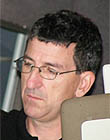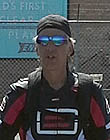|
|
This topic comprises 2 pages: 1 2
|
|
Author
|
Topic: SOLVED! Delayed Striking?
|
James Ness
Film Handler
Posts: 47
From: Houston, TX, USA
Registered: Jan 2008
|
 posted 06-27-2010 01:33 PM
posted 06-27-2010 01:33 PM





One of our Strong Super Lume X's, has just developed a weird problem, when you strike the bulb, it takes about 10-20 seconds before the bulb actually lights up, no noise, no nothing, just silence and then 'bing' it lights up. Runs perfectly fine, good light output, good amperage. Any ideas?
| IP: Logged
|
|
|
|
|
|
|
|
|
|
|
|
|
|
|
|
|
|
|
|
|
|
|
|
Dave Macaulay
Film God

Posts: 2321
From: Toronto, Canada
Registered: Apr 2001
|
 posted 06-28-2010 09:45 PM
posted 06-28-2010 09:45 PM




delayed striking(the original problem) on a Super Lume-X is often either a rectifier problem or a problem with the autostrike board. But you say the lamp takes as long to strike even if you push the manual strike button under the shiny plug/cap on top?
When you press that button is it making the ZZZZZ striker sound or does it wait the 10-20 seconds in silence and then strike the lamp? Silence suggests a rectifier problem or else a lamphouse interlock is open. There are few interlocks on the rectifier activating circuit - the switches have to be set properly, the side door has to be closed properly, and the airflow switch on the internal blower has to be activated (you can have a stack airflow switch too, but they are rare).
Is this new buzz/screech the ZZZZ striker sound you hear when pressing the manual strike button or is it something completely different?
Bit of a mystery anyway. There's not much in the lamphouse that can screech or buzz: just the fan and the ignitor, plus I guess the autostrike relay if it was going really mental. If it's the ignitor that's bad news since it will burn itself out pretty quickly if left on continuously.
The voltage at 80 is not right. Are you sure you are measuring voltage, not lamp amps? The pushbutton switch for reading volts is notoriously weak, and many don't actually switch even though pushed in as far as they will go. Try removing the plastic button cap (pulls straight off fairly easily) and pressing in on the metal stud that remains.
While you are waiting that 10-20 seconds try reading the voltage. It should be well over 100V volts with a switcher, about 80-90V with a high reactance rectifier. Lamp ON voltage must be roughly 20-24VDC. If you read zero volts then see it shoot up to 100+ just before the lamp autostrikes you have a problem most likely with the fan or the airflow vane switch. Less likely with the rectifier itself. If you have lots of volts but no autostrike then probably the autostrike board is failing. This is located on the inside back at the bottom behind a sheet metal shield. It sits on three plastic clip standoffs... but that's another problem. Strong used nylon standoffs, and nylon + UV light + time = fragile brittle stuff. Removing the board to service it will destroy those pins unless you have a brand-new lamphouse and Strong has used a size that I have never found anywhere except from Strong (8-32 threaded 1/4" PCB hex standoff clip pins). There is no easy substitute mounting method. So make sure the board is the problem before you remove it, and get replacement standoffs from Strong before you do. The board itself is pretty simple, a relay with the coil powered from lamp DC via a zener diode that basically subtracts a bunch of volts: simplified, to pull in the 24V coil relay coil (and power the ignitor unit) at 124V you use a 100V zener.
SO first make sure the lamphouse internal blower fan is clean (dirty blower wheels reduce airflow a LOT, and cinema air is unbelievably dirty... I have seen scary buildups of nasty gunk on lamphouse and rectifier fans) and free turning, and gets up to full speed blowing lots of air in a second or two after powerup. Then make sure the airflow vane switch is clean and free moving and activating within the fan speedup time (it should switch on at about 2/3 speed of a clean blower). Then make sure the rectifier is going into "DC ON" mode as soon as the vane switch operates. Then make sure the DC voltage gets up to 140V or so more or less instantly after the rectifier is at "DC ON". Finally check the autostrike board zaps the striker within a second of the DC voltage going above 120V. Usually with switchers the lamp strikes almost instantly once the lamp power is turned on (by automation or the manual ON rocker switch).
Something bad is going on with this lamphouse/rectifier. Continuing to use it "as-is" is not a good idea.
| IP: Logged
|
|
|
|
|
|
|
|
All times are Central (GMT -6:00)
|
This topic comprises 2 pages: 1 2
|
Powered by Infopop Corporation
UBB.classicTM
6.3.1.2
The Film-Tech Forums are designed for various members related to the cinema industry to express their opinions, viewpoints and testimonials on various products, services and events based upon speculation, personal knowledge and factual information through use, therefore all views represented here allow no liability upon the publishers of this web site and the owners of said views assume no liability for any ill will resulting from these postings. The posts made here are for educational as well as entertainment purposes and as such anyone viewing this portion of the website must accept these views as statements of the author of that opinion
and agrees to release the authors from any and all liability.
|

 Home
Home
 Products
Products
 Store
Store
 Forum
Forum
 Warehouse
Warehouse
 Contact Us
Contact Us




 Printer-friendly view of this topic
Printer-friendly view of this topic








![[Roll Eyes]](rolleyes.gif)
![[Big Grin]](biggrin.gif)





